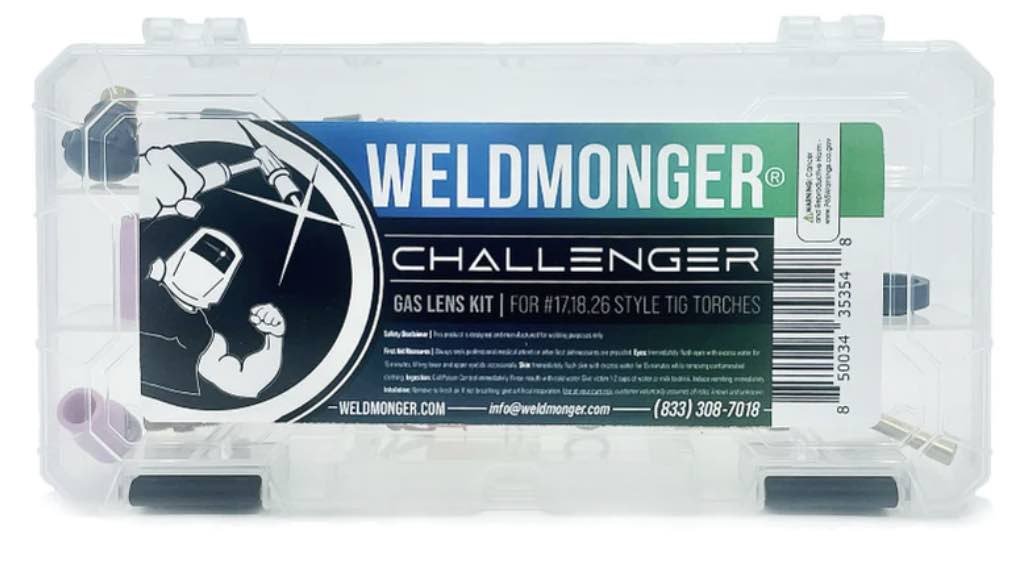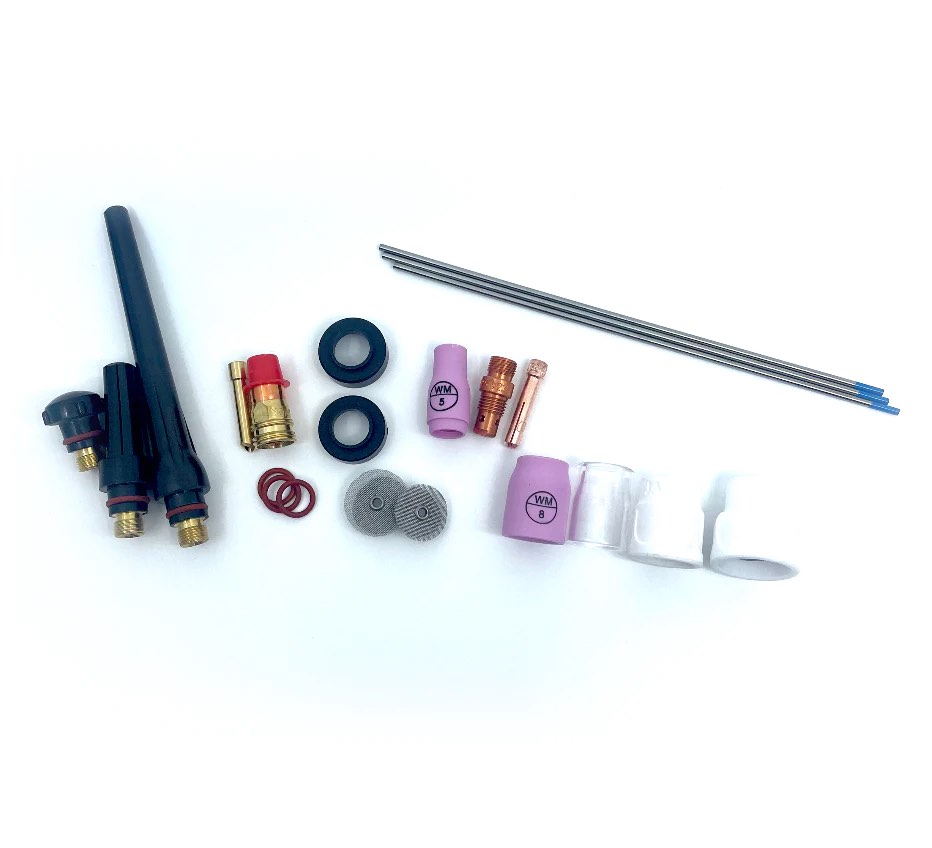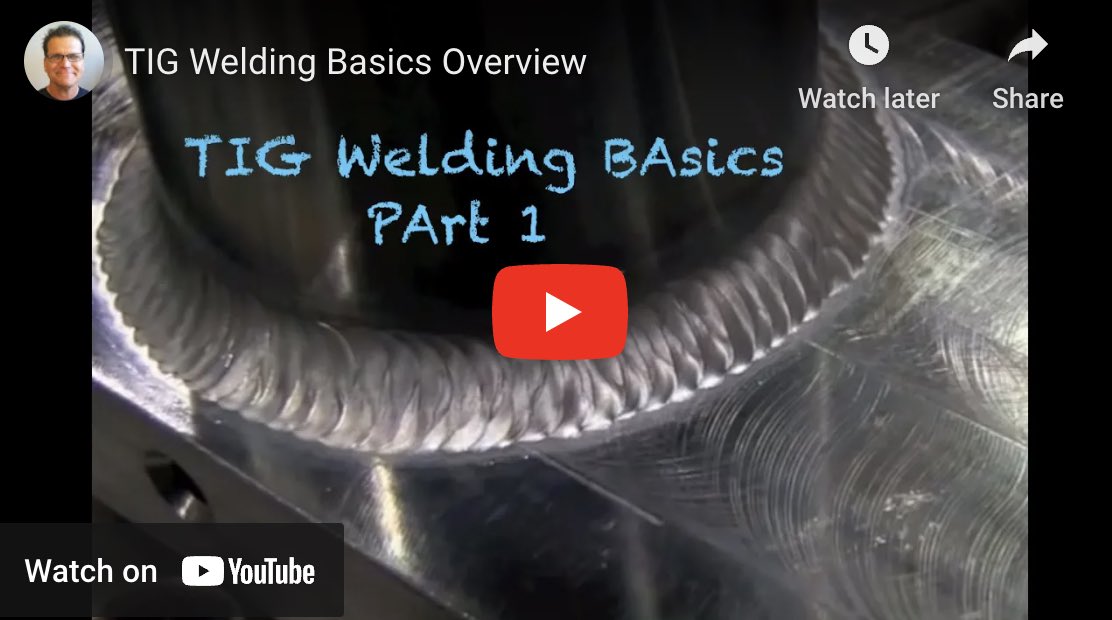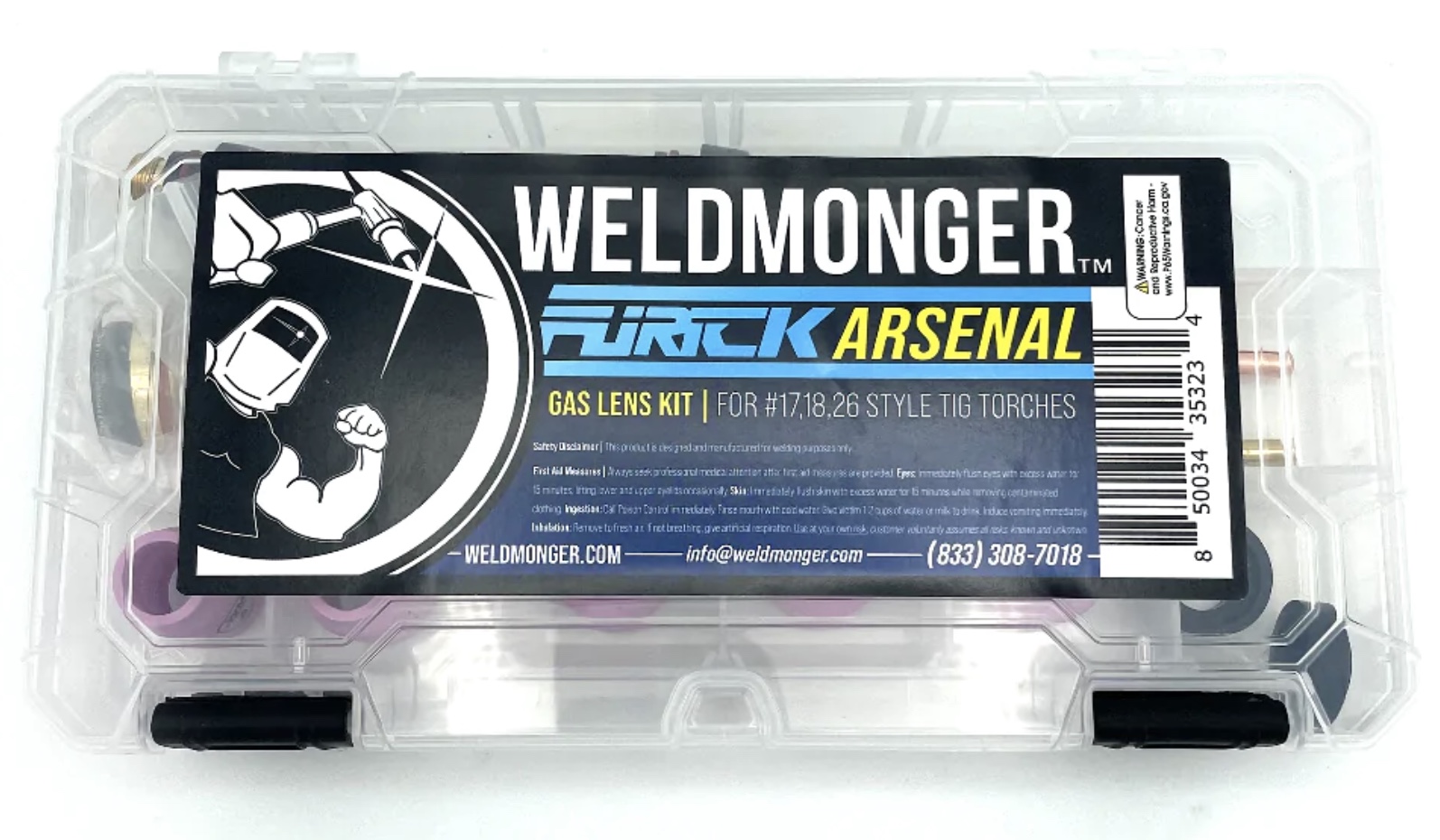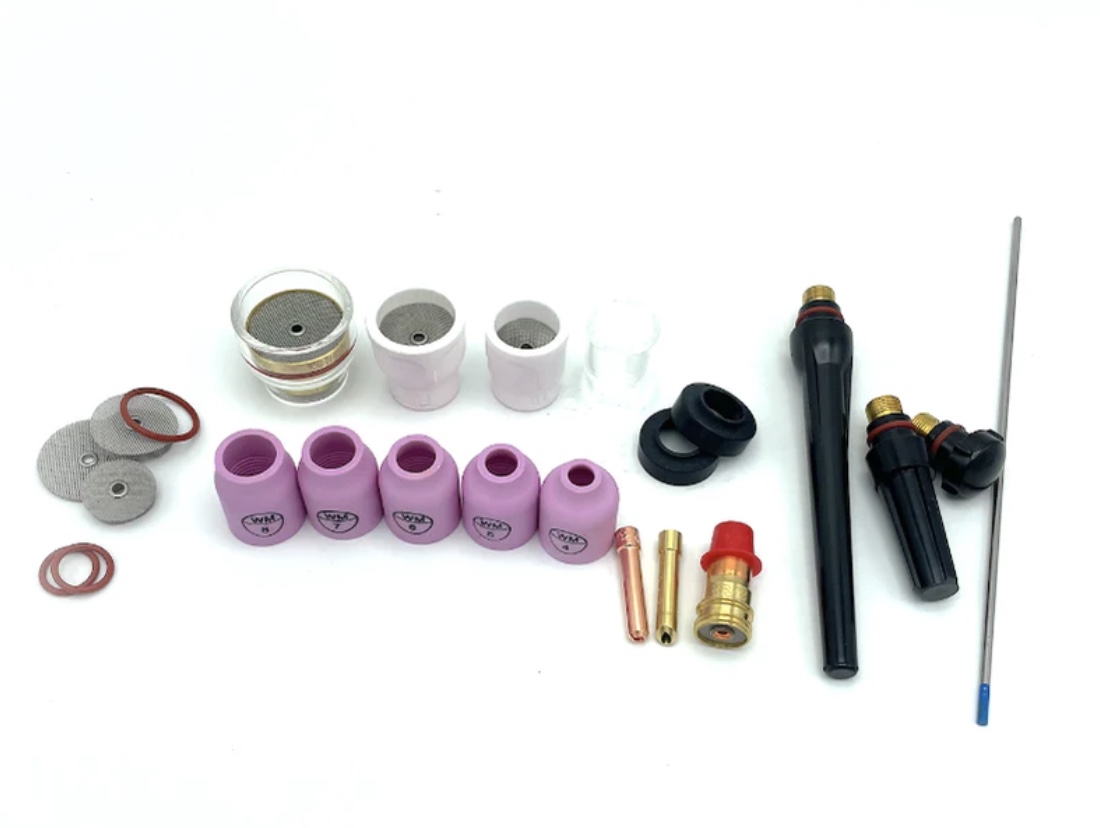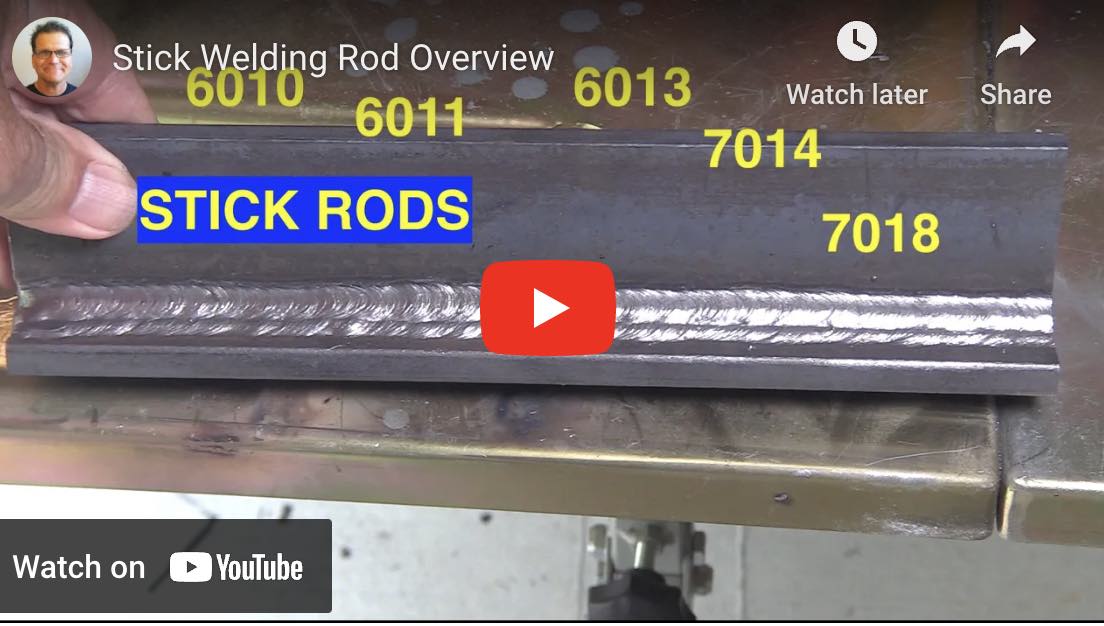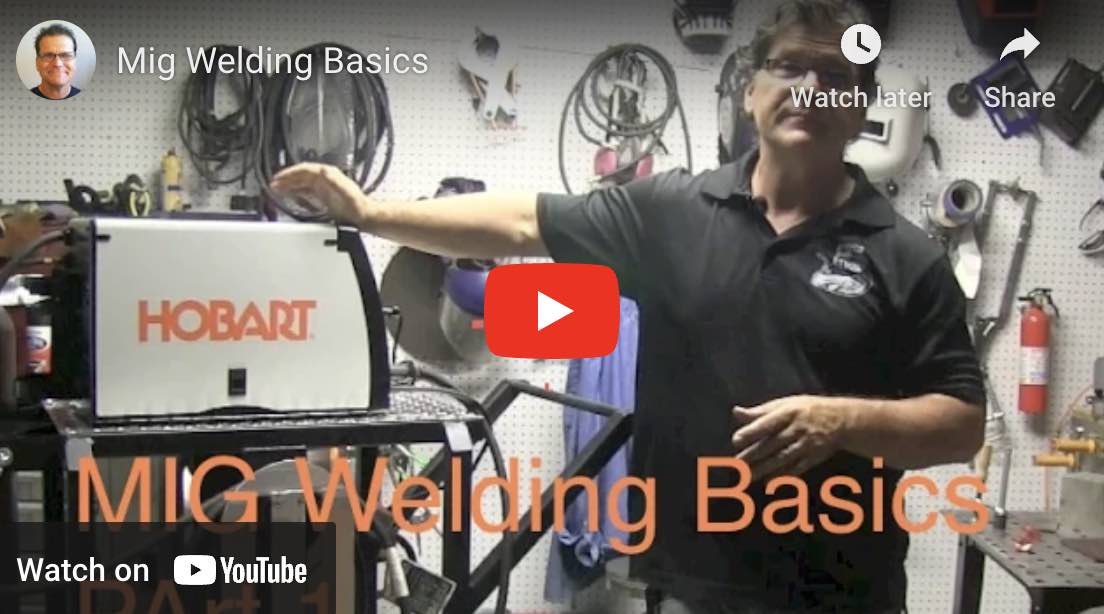Welding Fundamentals
What are the fundamentals of welding?
The basic and important things that every welder needs to know.
First and probably the most important thing to know about welding is that…
Heat affects metal......And it affects different metals in different ways.
...Introducing the New WeldMonger Challenger TIG kit that includes the most frequently used Cups.
For example, heating a piece of high carbon steel to a red hot temperature and cooling it quickly is how knife makers Harden a high carbon steel blade.
But heating a piece of 304 stainless to the same temperature and quick cooling it will not Harden the metal at all.
The heat from welding is just like what a knifemaker does to harden a blade.
Welding melts the base metal and the area next to the weld can Harden with certain metals.
Heat can also make some metals soft, or reduce corrosion resistance.
Heat from welding must be properly applied and controlled.
this is why procedures are established and applied.
All welding processes have a way to shield the molten weld pool from the atmosphere.
Elements in the normal air we breathe like oxygen, nitrogen, and hydrogen cause problems with welding.
Each welding process has a way of preventing these elements from reacting with the molten weld puddle.
In tig welding, the shielding gas …usually argon , protects the weld puddle.
In stick welding, the flux on the stick electrode protects the molten metal.
In gas metal arc welding, (more commonly called mig welding in the states) the shielding gas does the trick.
In self shielded flux core welding, there is flux inside the wire that provides the protection.
In oxyfuel torch welding, aka gas welding, the flame consumes the oxygen and provides protection.
There are even welding processes like electron beam welding where the welding is performed in a vacuum where the air is removed.
***Remember this key point because when things go wrong in welding, checking the shielding mechanism is part of any effective troubleshooting checklist.
One of the main defects caused by inadequate shielding of the molten puddle is porosity.
Porosity can be caused by dirty metal too.
Porosity with stick welding? has the rod been properly stored in a rod oven to prevent moisture? Is the flux coating cracked?
Porosity with mig welding? Either the metal is not clean enough, or there is a shielding gas issue.
Shielding gas issues can be using the wrong or contaminated shielding gas, windy conditions, not enough or restricted gas flow, or a leak.
You get the picture.
When porosity happens, the shielding gas and the level of cleanliness of the metal are the 2 main things to check first.
All metals weld better if they are clean. So even with stick welding, oily metal, or mill scale can contribute to porosity.
I am not saying that you cant weld over mill scale with a stick electrode. But I am saying that since some mill scale coatings are very thick, and mill scale is essentially just a very thick layer of oxidation, that removing mill scale is never a bad practice.
Fundamentals of Gas Tungsten Arc welding (gtaw) commonly called TIG welding
I have created a No BS TIG workbook for you to help you learn to TIG weld...and its free
Download your Free TIG workbook here
Download your Free TIG workbook here
Tungsten Inert Gas (TIG) welding, also known as Gas Tungsten Arc Welding (GTAW), is a welding process that uses a non-consumable tungsten electrode to create the weld. Here are the fundamentals of TIG welding:
- Power Source: TIG welding requires a suitable power source, typically a direct current (DC) or AC DC TIG welder that does DC as well as alternating current (AC)
- Tungsten Electrode: The tungsten electrode is a non-consumable electrode that carries the electric current to the arc. It is made of pure tungsten or a tungsten alloy and has excellent heat resistance. The electrode is sharpened to a point for DC welding and usually slightly rounded for AC welding, and the type of electrode used depends on the material being welded.
- Shielding Gas: TIG welding uses an inert shielding gas to protect the weld area from atmospheric contamination. Typically, argon gas is used as it is non-reactive and prevents oxidation of the weld. The gas is directed over the weld area through a cup or nozzle to create a protective gas shield.
- Welding Torch: The TIG welding torch holds and controls the tungsten electrode and provides a means to direct the shielding gas to the weld area. It sometimes includes a control switch or amperage control.
- Filler Metal: In some cases, TIG welding requires the addition of filler metal to the weld joint. The filler metal is made of a similar or compatible material to the base metal being welded. It is typically manually fed into the weld pool to reinforce and fill the joint.
- Clean and Prepped Surfaces: Proper surface preparation is the key in TIG welding. The base metals being joined must be clean and free from contaminants such as dirt, grease, rust, or paint. Typically, the surfaces are cleaned using a wire brush, grinder, or chemical cleaning methods.
- Welding Technique: TIG welding requires precise control and skill. The welder holds the torch at the correct angle and distance from the workpiece, maintaining a steady arc length. The filler metal is added to the weld pool as needed to create a strong and consistent weld.
- TIG welding is commonly used for welding stainless steel, aluminum, copper, and other non-ferrous metals. It provides precise control, high-quality welds, and excellent aesthetics, making it suitable for applications where strength, appearance, and accuracy are needed.
Fundamentals of Shielded Metal Arc Welding
Shielded Metal Arc Welding (SMAW), also known as stick welding or manual metal arc welding, is a popular welding process that utilizes a consumable electrode coated with a flux to join metal pieces together. The fundamentals of Shielded Metal Arc Welding include the following:
- Power Source: SMAW typically requires a direct current (DC) power source, although some applications may use alternating current (AC) as well. The power source provides the necessary electrical energy to create an arc between the electrode and the workpiece.
- Electrode: SMAW employs a consumable electrode, which is a metal wire coated with a flux material. The electrode serves as both the filler metal and the electrode that carries the electrical current to create the arc. Various electrode types are available for different applications and metal types.
- Flux Coating: The electrode is coated with a flux material, which plays several crucial roles during the welding process. The flux coating acts as a shielding gas, protecting the weld pool and the arc from atmospheric contamination. It also contributes to the formation of slag, which aids in the protection of the weld as it cools. The flux coating may contain additional elements to alter the characteristics of the weld, such as stabilizers, deoxidizers, or alloying agents.
- Arc Ignition: To initiate the welding process, the electrode is brought into contact with the workpiece and then quickly withdrawn to establish an arc. The arc creates an intense heat that melts the electrode and the workpiece, forming a weld pool.
- Welding Circuit: The welding circuit includes the power source, electrode holder or stinger, and the workpiece. The circuit is completed when the electrode makes contact with the workpiece, allowing the electric current to flow through the circuit and sustain the arc.
- Welding Technique: The welder controls the movement of the electrode and the deposition of the filler metal. The electrode is moved along the joint at a controlled speed, and the arc length is maintained within a specific range to ensure stable and consistent welding.
- Slag Removal: After each pass or layer of weld metal is deposited, a layer of slag forms on the surface. Once the slag has cooled, it is chipped or brushed away to reveal the underlying weld bead.
- Post-Weld Treatment: Depending on the application and requirements, SMAW welds may undergo additional processes after welding, such as grinding, cleaning, or post-weld heat treatment to enhance the strength, integrity, and appearance of the welded joint.
Fundamentals of gas metal arc welding aka MIG welding
Gas Metal Arc Welding (GMAW), also known as Metal Inert Gas (MIG) welding, is a widely used welding process that utilizes a consumable electrode wire and an inert gas to create an electric arc between the electrode and the workpiece. Here are the fundamentals of gas metal arc welding:
- Power Source: GMAW requires a power source, typically a constant voltage (CV) welding machine.
- Electrode Wire: GMAW uses a continuously fed consumable electrode wire, which acts as both the filler material and the electrode. The wire is typically made of a specific alloy or a combination of alloys suitable for the welding application.
- Shielding Gas: A shielding gas, such as argon or a mixture of argon and carbon dioxide or other gases, is used to protect the weld zone from atmospheric contamination. The shielding gas creates a stable arc and prevents the molten metal from reacting with oxygen and nitrogen in the air.
- Welding Gun or Torch: The welding gun or torch holds and guides the electrode wire to the workpiece. It also directs the flow of shielding gas to protect the welding area.
- Welding Parameters: Various parameters, including voltage, amperage, wire feed speed, and shielding gas flow rate, need to be set correctly to achieve proper weld penetration and bead shape. These parameters depend on factors such as material thickness, joint design, and welding position.
- Welding Techniques: GMAW can be performed in different positions, such as flat, horizontal, vertical, and overhead. Some variations of GMAW like spray transfer are too hot for welding uphill. Proper welding techniques, such as maintaining a consistent travel speed, angle, and distance between the gun and workpiece, are crucial to produce quality welds.
GMAW is widely used in various industries due to its versatility, ease of automation, and ability to weld a wide range of materials and thicknesses. It is commonly employed for fabrication, manufacturing, automotive, and construction applications.

